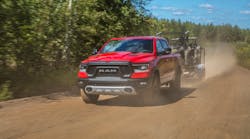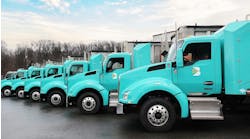To say that the global automotive industry is at the start of an unprecedented technological revolution is an understatement. For the first time in well over a century, every single aspect of personal and commercial vehicles is undergoing an assessment and a realignment. This includes battery-electric vehicle (BEV) powertrains, alternative/zero-emissions fuels (such as hydrogen fuel cell systems), and rapidly advancing autonomous vehicle control systems, which stands poised to disrupt everything from infrastructure to vehicle design and even traditional ownership models.
It is important to remember that this revolution, though its eventual consequences may well be far-reaching, is in the early stages. And even when it gains steam, it will initially begin on the coasts of the nation and in large metropolitan areas. That means, for the foreseeable future, the vast majority of commercial fleets will be relying on tried-and-true internal combustion engine (ICE) technology, using either gasoline or diesel fuel.
For pickup, light truck, and van OEMs, this means pursuing dual technology paths in the near term until the reliability and durability of BEV powertrains are proven and gain large-scale acceptance in the marketplace.
And for commercial vehicle owners and operators, a lot more time, consideration, and money will go into what has traditionally been a fairly straightforward annual event: refreshing your fleet. Soon, all-new powertrain options and capabilities will be on the table, and new calculations will enter into the picture. For example, at some point, it seems likely a fleet that has traditionally been 100% ICE vehicles will have to factor in vastly reduced resale values for those trucks at trade-in time—assuming, of course, that BEV trucks and vans eventually gain market dominance. And the same consideration may be the case for companies looking to trade in vehicles without autonomous control systems.
In the meantime, however, there is still work to be done. In Detroit specifically, the Big Three OEMs—Ford Motor, General Motors, and Stellantis—are still building trucks with cutting-edge powertrains to help you do it. And they are developing powertrains for everyone, including those ready to try out powerful yet quiet plug-in pickups, and those who just want a tried-and-true diesel- or gasoline-powered truck to get to the end of the workday.Dual paths
Where do things stand today with the Big Three in terms of BEV and ICE production?
For now, not much has changed for fleet managers determining which type of ICE is best for their applications, according to Connor Dunlop, Ford Pro truck brand manager. “Fleet managers generally choose the powertrain based on the truck application,” he explained. “Gas trucks are generally chosen for applications with lighter duty cycles and lower torque requirements. Customers with high-capacity PTO requirements or the need to tow fully laden trailers over long distances tend to prefer diesel powertrains.
“Telematics tools like Ford Pro Telematics can help fleet managers analyze their vehicle usage and make informed operating and purchasing decisions in the future,” Dunlop said.
Daniel Tigges, commercial product and sales support manager at Chevrolet, said that generally, gasoline-powered trucks account for around three-fourths of sales, with diesel making up about one-quarter, although he cautioned that those trends vary over time and according to a wide range of external factors.
Tigges also noted that General Motors CEO Mary Barra announced at the 2022 Consumer Electronics Show that the company will introduce fully electric versions of its HD trucks by 2035. “Without question we are seeing more fleets interested in battery-electric commercial vehicles,” Tigges said. “We are seeing incredible interest for the 2024 Silverado EV Work Truck. And these all-electric HD trucks will be engineered to deliver effortless heavy-duty hauling and towing while offering customers amazing new features and a range needed to get the toughest jobs done.”
At the same time, Chevy engineers are working on new ICE designs that are helping deliver better performance and better fuel economy while also helping reduce emissions, Tigges added. He pointed out that diesel engines deliver higher horsepower and torque, especially at low rpms where it is most useful for towing and moving heavy loads. “They also deliver better overall fuel economy,” he noted. “But that is often offset somewhat by higher fuel prices per gallon. They also generally have higher maintenance costs. Gas engines typically have a much lower acquisition cost which provides a big total cost of ownership advantage. Commercial buyers tend to buy diesels when they have use cases that require maximum performance.”
Similarly, Dave Sowers, head of Stellantis-owned Ram Commercial Trucks, said that Ram is committed to having fully electrified solutions in a majority of its segments by 2025 and a full portfolio of electric solutions for all of its segments no later than 2030. But, he added, right now, Ram customers really want the best of both worlds: They want gobs of power in as economical an engine as they can possibly get.
“When we talk to heavy-duty buyers, they tell us they’re looking for both towing capability and engine performance,” he said. “And Ram Heavy Duty’s available High Output diesel engine enables the most powerful, most capable pickup in the segment to tow up to 37,100 lbs. Ram Heavy Duty was the first to break the 1,000 ft.-lb. torque rating envelope.”
Sowers said that to meet those seemingly conflicting customer demands, Ram chose three robust ICE engine offerings for the Heavy Duty:
- 6.4L HEMI V-8 with “best-in-class” standard gas engine power produces 410 hp at 5,600 rpm and 429 lb.-ft. of torque at 4,000 rpm—featuring VVT with Fuel Saver Technology cylinder deactivation
- 6.7L Cummins Standard-Output Turbo Diesel produces 370 hp and 850 ft.-lb. of torque (Ram 2500 and 3500)
- 6.7L Cummins High-Output Turbo Diesel produces 420 hp and 1,075 ft.-lb. of torque (Ram 3500)
For the off-road drivers more concerned about speed and power than fuel, the Ram 1500 TRX’s 6.2 V8 engine roars up 702 hp and can tow 8,100 lbs. It gets 14 mpg at most, though. For more fuel efficiency, Ram customers can opt for the 3L EcoDiesel engine (260 hp and 480 ft.-lb. of torque), which can get 33 mpg (highway), provides 12,560-lb. towing capacity.
On the flipside, Ford Pro is all in on electric work horses over fossil-fuel guzzlers.
“Obviously, all-electric trucks are a hot topic at Ford, as we just started production of the F-150 Lightning—the only full-size electric pickup available now—with a starting price less than $40,000,” Dunlop said. Ford does not yet offer a BEV option for Super Duty, he noted.
On the ICE front, Dunlop said the 7.3L gasoline V8 in the 2022 Ford Super Duty is the most powerful gas engine in a full-size pickup, delivering the best gas horsepower (430 hp at 5,500 rpm) and torque (475 ft.-lb. at 4,000 rpm) in its class. “For the toughest applications, the third generation 6.7L Power Stroke V8 Turbo Diesel engine offers ‘best-in-class’ diesel horsepower at 475 hp at 2,600 rpm (lower than any other engine) as well as an available 1,050 ft.-lb. of torque at 1,600 rpm,” he said. “And building on those options, all Ford Super Duty pickups (other than the F-250 with 6.2L V8 engine) feature the Ford TorqShift 10-speed automatic transmission that has been engineered to optimize drive ratios and leverage the available horsepower and torque to improve the overall operating performance.”
Advanced technologies like direct injection and variable valve timing are helping to provide better performance and fuel economy, Tigges said, adding that new PTO options are now helping customers use that power better for jobs and fleet vehicles. “For example,” he noted, “On the Chevrolet heavy-duty Silverado, we offer an Allison 10-speed transmission with an integrated PTO. This design eliminates the need to buy an aftermarket PTO unit to attach to the transmission. It saves upfit time and costs and is more efficient, quieter, and transmits more power.”
Earlier this year, Chevy revealed the 2024 Silverado EV, which will use GM’s Ultium EV Platform. Expected specs include a 400-mile range, 780 ft.-lb. of torque, and 0-60 mph in under 4.5 seconds. Max trailering will reach 10,000 lbs.New technology everywhere
The transportation revolution isn’t just taking place under the hood. New light- and medium-duty trucks are receiving a host of new technology upgrades inside the cab and out—all with a laser-like focus on helping fleets work smarter, harder, and more efficiently.
In fact, Ford’s Dunlop argued that some “new” technologies have already transitioned to the status of “must-have” vehicle systems. “Telematics are important no matter what size fleet you have,” he said. “Ford Pro Intelligence makes it easier than ever for commercial customers of all sizes to use telematics to improve their vehicle uptime. Ford Pro Telematics Essentials is a complimentary web-based application that’s available to all our customers who have gas-powered Ford vehicles with embedded modems in their fleets. It provides instant odometer readings, diagnostic trouble codes, recall notifications, trackable maintenance alerts, and information around engine hours and oil life. It will even relay warning lights so fleet managers can resolve issues faster without having to wait for drivers to report issues—potentially avoiding costly repairs down the line. And customers who want to access more advanced capabilities can easily upgrade to the Ford Pro Telematics subscription service that offers additional productivity features, including GPS tracking, driver behavior insights, support for non-Ford commercial vehicles, a mobile driver app, and more.”
Thanks to GM’s OnStar Vehicle Insights, Tigges said Chevrolet and GMC vehicle owners now have access to electronic features like oil life, air filter, and brake life monitoring. “Vehicle Insights not only advise when maintenance needs to be done but can help predict when it will be needed based on how the truck is being used,” he added. “This allows fleet managers to schedule maintenance to keep their vehicles running at maximum efficiency.”
Additionally, Tigges said, smartphone apps are becoming a valuable interface between vehicles and owners/fleet managers as well. “Silverado HD offers great towing capability along with the Advanced Trailering System with an in-vehicle app that offers customized trailer profiles, pre-departure check lists, trailer lighting diagnostics, trailer tire pressure monitoring system module, and ability to create and sync trailering profiles with the myChevrolet Mobile App,” he said. “Outside of the Advanced Trailering System, Silverado HD also offers Electric Parking Brake hookup assist, brake gain memory on integrated trailer brake controller, and trailer theft alert.”
With new pickups, technology both under the hood and in the cab will be driving great changes in the years ahead. The truck of the future is always a year away. But new technology is changing how fleets work—and will work—in ways that seemed unthinkable just a decade ago.






